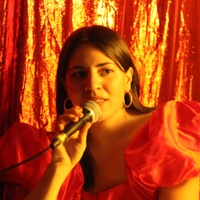How to organize and host a small-budget event
My name is Annie Bielski. I’m a visual artist, writer, and performer, and over the last five years I’ve organized and hosted events at numerous galleries and venues. I’ve also performed my own writing of tragicomedy and poems in all sorts of diverse spaces, from my friend’s living room to the MoMA. Based on my experiences, below are some tips about how to put on a live, DIY event if you’ve never done it before, and if you’re on a tight budget. This will be helpful to you if you’re looking to organize something on your own, but could use some guidance as you think things through. If you follow these tips, you can expect to produce a fun, well-thought-out event that brings people together for a shared experience—without breaking the bank.
— Annie Bielski

What do you need to produce a creative event on a budget?
The basic things you must have in order to put on an event are: an idea, communication skills, a space, and people. As you start to think through your event idea, get specific about what feeling you’re going for: Do you hope people laugh? Do you hope people cry? Do you hope people dance? Spend some time getting clear on your vision for whatever event you hope to produce, then follow these tips to lock down the details.
Step 1: If you’re on a budget, make a budget.
How much money can you afford to spend on this event, and where will the money come from? Make a list of everything you’ll need to pull off the event, then, using the total amount you have to spend, break down how much you can afford to put towards various aspects of the show.
If you’re on a tight budget, think of ways you can get what you need without exchanging money. Consider barter and in-kind payments when it comes to friends with skills, equipment, or space to share. For example, if you are going to pay your DJ by walking her dog the following week, include it in your budget and follow through.
Below are a few budget items you may want to consider for your event:
- Venue booking fee
- Artist fees for participants/performers
- Accommodations you may provide to participants (Your couch? In-kind.)
- Cost of printing fliers for promo
- Photographer fee
- Food & drink for self and performers
- Travel (gas $, a train ticket for a performer, etc.)
- Additional equipment rentals
- Etc…
Step 2: Research venue options, and choose one that suits your vision for the event
A venue is a place where things can happen. It can be a garage, library, bar, theatre, field, parking lot, gallery, sidewalk, book store, boat, arena, radio show, blanket, or anything else you can dream up. Do you have access to any of the above? Do you know someone who knows someone?
If you’re thinking about putting on an event at an established venue you’ve never worked with before, do some research on the space and consider how where the event happens will affect its overall feeling. Get a sense of who the venue is and what they stand for. Is the space accessible and inclusive? Do you feel comfortable there, and will your performers and audience members feel welcome?
Step 3: Get clear on your event’s needs
Consider what you want to happen at your event, and make a list of the equipment and other resources you’ll need to pull it off. Ideally, you already considered what you’ll need when you made your budget. For example, if you’d like to have a dance party, you’ll need loud speakers and room for people to dance, but if you’d like to host a dream-journal reading in your living room, you can get away without needing any equipment at all.
Once you have your equipment list made and venue chosen, discuss the following with your venue contact to ensure you understand exactly what they can provide.
Some basics to go over with the venue:
- Equipment they can provide (vs. what you’ll need to bring)
- A sound professional to help set up the stage, mix live sound, cue up any music or sound effects, and play music between sets
- Scheduling a sound / tech check with performers and the sound professional
- Staffing (door person, security, cleaning)
- Green room space; snacks/drinks for performers
- Help promoting event via their social media platforms, website, mailing list, a flier in their window, etc.
- Discuss how $ is handled (including venue rental fees, what the cost of admission will be, and how to split any earned funds)
- Point of contact for the day of the event. This person may let you into the venue to get set up before it’s open to the public, show you the green room, give you drink tickets to distribute, help divide and distribute funds after the show, etc. This is also your contact in case of emergency.
Step 4: Invite performers & participants
When reaching out to performers who you’d like to include in your event, it’s a good idea to give them enough info up front so they can decide if it’s something they are able to and desire to participate in without too much back-and-forth. In your invitation, add a note about how you know of them, or what you appreciate about their work. It’s also smart to include a well-written overview of the event that gets them excited about being involved.
In your outreach to potential participants, address the following briefly:
- Location, date, and time of event
- Theme or idea behind the event (“A comedy show with a house band,” “an evening of poetry performed atop my grandma’s quilt in the park,” etc.)
- Title of the event (if possible)
- Other confirmed performers (if possible)
- Include a note about money/artist fees, such as:
“We’ll split the money collected at the door with the venue at / percent in our favor, then distribute the rest equally among ___ performers.”
“Since the cost of attending this event is sliding-scale, it’s difficult to say exactly how much money will be made at the door. I can guarantee you at least $___ for your time, and perhaps more.”
“Profits collected at the door will go toward ___, as this event is a benefit. I hope you will consider your performance as part of this donation.”
Consider additional offerings you can provide to performers. Pizza before the show? Professional documentation of their performance? Drink tickets?
Step 5: Once confirmed, send a follow-up email to performers.

In your correspondence with performers, also address the following:
- Ask them for a short bio and a picture to use for promoting their inclusion in the event.
- Ask for a general idea of what they are planning to perform and what equipment they may need. Let them know what you and/or the venue are able to provide. While it is nice to help out, you do not have to take on the responsibility of sourcing specific equipment (beyond the basics) for your performers.
- Tell them how much material to prepare (eight minutes of jokes, six songs?), and give them a sense of where they fit into the show flow.
Step 6: Promote.
Once your event is feeling pretty well planned, it’s time to promote it to all the people you hope will attend. Make a flier to post online (on social media, websites, and anywhere else you can think of) and IRL. Draw one by hand, on your phone or computer, or make a short video flier using a free video app, such as iMovie or WeVideo.
Include the following info in your flier:
- Title of the event
- Location, date, time doors open, time show starts
- Cost to attend event
- Lineup/performers
- A brief description of the event
- A note about what the event is a benefit for (if applicable)
The size of the event will dictate how far in advance you should start promoting. If you’re trying to fill a big space, send an email invite to your friends, people you want to be friends with, family, neighbors, lovers, etc. Ask your performers to do the same (send them your flier so they can use it, too!). Post online more than once—I’ve found that making at least two to three social posts, including one on the day of the event, is most effective. Put a flier up in the venue and in the spaces around it. Reach out to your local newspaper, friend with a radio show, or the town gossip to help spread the word.
Step 7: Pre-show to-do list
Before the event, you’ll want to follow these tips to ensure a smooth show—and to make sure that once the event is over, you have great photos to remember it by.
Make sure to do the following in advance of your event:
- Schedule a sound/tech check with your performers. It’s a good idea to do this at least an hour before the doors open, in case you encounter any hiccups.
- Make a show flow that includes what each performer is doing, what equipment they’ll need, how long their performance will last, and any other timing constraints you’re working with. You may want to include notes to self about how you want to introduce each performer.
- Depending on the type of event, it’s also great to thank the space, remind the audience to tip the bartenders, silence their phones, etc.
- Arrange photo/video documentation. You will likely get some photos from audience members taking pics on their phones and posting to social media. However, if possible, it’s always nice to have someone who has been specifically tasked with documenting your event with a high-quality camera.
- Eat something and drink some water. Have fun. This is your event, after all!
One last thing to note: Know that some performers go inside themselves before going on stage and may need time and space away. If someone seems standoffish, they might just be getting into their zone. Respect that everyone has different methods backstage that enable them to do what they do on stage.
Step 8: Showtime
Make room for the unknown!
Lots of things can and will not go as planned. Your band may suddenly come down with the flu and not show up, but a heckler will. The audience may not feel as big as you want, or it may end up being overwhelmingly large. Either way, keep going.
Be a generous host.
You want to make each person feel appreciated and seen. When introducing a performer, remember to say their full name or name they perform under. Your introduction is not a great time to make a joke at their expense—unless it’s something you worked out together beforehand. Stay on your toes and, as much as possible, be present with what is happening on stage and off. If you are hosting an experimental talk show and the experimental seating your guest is sitting on breaks on stage in front of the audience, plop down on the stage next to them and continue with the interview.
Step 9: The next day
Meet with your venue contact ASAP to deal with $.
- Distribute the $ among performers as soon as possible (if you have it in cash, try to distribute funds before everyone takes off for the night).
- Send performers a thank-you email. Tell them what you liked about their performance, or what you connected with.
- If the event was a fundraiser, let performers know how much $ was raised with their help.
- Collect event documentation in one place, and let performers use the images in their personal social media, websites, etc.
- Take a breath! You did the thing you set out to do.
In summary…

Then, do it all again.

